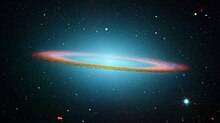Galaktyka Sombrero
 Messier 104 – Galaktyka Sombrero (HST) | |
| Odkrywca | |
|---|---|
| Data odkrycia | 11 maja 1781 |
| Dane obserwacyjne (J2000) | |
| Gwiazdozbiór | |
| Typ | SA(s)a |
| Rektascensja | 12h 39m 59,4s |
| Deklinacja | −11° 37′ 23″ |
| Odległość | 29,35 mln ly |
| Przesunięcie ku czerwieni | 0,003642[1] |
| Jasność obserwowana | +8,7m |
| Rozmiary kątowe | 8,7′ × 3,5′ |
| Charakterystyka fizyczna | |
| Wymiary | 38 tys. ly |
| Alternatywne oznaczenia | |
| M104, NGC 4594, PGC 42407, UGCA 293, MCG-02-32-020 | |
 Położenie M104 w gwiazdozbiorze Panny | |
Galaktyka Sombrero (również Messier 104, M104, NGC 4594) – galaktyka spiralna typu Sa, położona w południowej części gwiazdozbioru Panny, tuż przy granicy z konstelacją Kruka[2] o jasności 8,7m i nazwie pochodzącej od jej wyglądu (przypomina kapelusz sombrero).
Odkrył ją Pierre Méchain 11 maja 1781 roku. Nie znalazła się w oryginalnej drukowanej wersji katalogu Messiera, jednak Charles Messier dopisał ją odręcznie do swej prywatnej kopii katalogu. Niezależnie galaktykę odkrył William Herschel 9 maja 1784 roku, a John Dreyer skatalogował jego obserwację w swym katalogu jako NGC 4594. Dopiero w 1917 roku Camille Flammarion odkrył, że obiekt NGC 4594 był obserwowany wcześniej przez Méchaina i znany był Messierowi, dlatego w 1921 roku dodał tę galaktykę do katalogu Messiera jako M104[3].
Galaktyka Sombrero ma wielkie jasne jądro, mało rozwinięte ramiona spiralne i jest częściowo przesłonięta pasem (torusem) nieświecącej materii, składającym się głównie z pyłu i zimnego gazu wodorowego. Jej pierścień ma średnicę 60 tys. lat świetlnych[4]. Jest to galaktyka z aktywnym jądrem typu LINER[1].
Do jej obserwacji konieczny jest amatorski teleskop[2].

Galaktyka ta zawiera wiele gromad kulistych, które tworzą wokół niej sferyczne halo. Sombrero znajduje się w odległości około 30 milionów lat świetlnych. Nie jest pewne, czy należy do jakiejś grupy lub gromady galaktyk.
Zobacz też
Przypisy
- ↑ a b Galaktyka Sombrero w bazie SIMBAD (ang.)
- ↑ a b Jan Desselberger. Niebo nad Polską. „Urania - Postępy Astronomii”. 1 (775), s. 66, styczeń-luty 2015. Polskie Towarzystwo Astronomiczne. Polskie Towarzystwo Miłośników Astronomii. ISSN 1689-6009 (pol.).
- ↑ Courtney Seligman: NGC 4594 (ang.). Celestial Atlas. [dostęp 2015-07-28].
- ↑ Michał Różyczka. Głowa do góry. „Wiedza i Życie”. 1 (829), s. 70, 2004-01. Agora S.A.. ISSN 0137-8929 (pol.).
Linki zewnętrzne
- Messier 104 w SEDS.org (ang.)
- Galaktyka Sombrero w bazie SIMBAD (ang.)
- Galaktyka Sombrero w NASA/IPAC Extragalactic Database (ang.)
Media użyte na tej stronie
The famous Sombrero galaxy (M104) is a bright nearby elliptical galaxy. The prominent dust lane and halo of stars and globular clusters give this galaxy its name. Something very energetic is going on in the Sombrero's center, as much X-ray light has been detected from it. This X-ray emission coupled with unusually high central stellar velocities cause many astronomers to speculate that a black hole lies at the Sombrero's center - a black hole a billion times the mass of our Sun.
NASA/ESA Hubble Space Telescope and NASA's Spitzer Space Telescope joined forces to create this striking composite image of one of the most popular sights in the universe. Messier 104 is commonly known as the Sombrero galaxy because in visible light, it resembles the broad-brimmed Mexican hat. However, in Spitzer's striking infrared view, the galaxy looks more like a "bull's eye."
Spitzer's full view shows the disk is warped, which is often the result of a gravitational encounter with another galaxy, and clumpy areas spotted in the far edges of the ring indicate young star-forming regions.
The Sombrero galaxy is located some 28 million light-years away. Viewed from Earth, it is just six degrees south of its equatorial plane. Spitzer detected infrared emission not only from the ring, but from the center of the galaxy too, where there is a huge black hole, believed to be a billion times more massive than our Sun.
The Spitzer picture is composed of four images taken at 3.6 (blue), 4.5 (green), 5.8 (orange), and 8.0 (red) microns. The contribution from starlight (measured at 3.6 microns) has been subtracted from the 5.8 and 8-micron images to enhance the visibility of the dust features.Autor: Szczureq, Licencja: CC BY-SA 4.0
Gwiazdozbiór Panny. Mapa została stworzona przy pomocy programu PP3 autorstwa Torstena Brongera. Wersję wektorową stworzył Szczureq według wzoru z wersji rastrowej, której autorem jest BlueShade.


